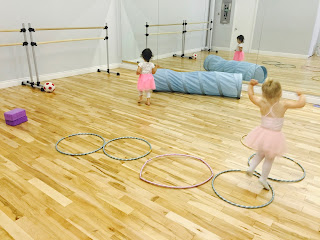Children have a natural curiosity and desire to explore. They need unstructured time to try new things, create, and test ideas. They need time to play. Play is enjoyable, creative, spontaneous, child-led and has no predetermined end goal. I'm a believer that the most learning happens when children play without inhibitions, guided solely by their own natural curiosities. Play is an important part of a child's cognitive, social, and even physical development.
In the dance studio, where I often teach 1-hour "Creative Movement" classes for children between 2 and 5 years, I reserve a minimum of 15 minutes for free play and here is why. Given access to the right materials, through play, a child can develop a greater understanding of their body and how it moves. In this type of play they will be strengthening large muscles groups and improving overall physicality. At the same time they will be role playing, using oral communication skills, socializing, and problem solving. There is no structured, adult-directed activity that provides the same opportunity for growth. In the context of physical development and gross motor skills, it is their time to make sense of their body and how it can move.
To encourage movement and learning I give the students a variety of props. I vary what they have access to each time so that they are encouraged to try new things.
Some of the props I often put out include:
- yoga blocks
- hula hoops
- variety of balls
- bean bags
- ribbons
- scarves
- animal shapes
This doesn't mean that there is no adult involvement in play. The role of the educator or parent is to create an environment with opportunity for rich, playful learning experiences. You can recognize appropriate times to insert yourself into a child's play and extend the thinking and movement that is happening. For example, when I see a child playing with a scarf (often making it a cape, hat, or tail) I might say "I see you have a cape. What else can this scarf be?" or "I see you have a tail. What kind of animal are you? Do you crawl, walk, or fly?". I ask questions purposefully that encourage them to think, talk, or move, depending on what I feel will best extend their play.
From my experience I have learned that it is important to remember that free play is not a reward for good work, it is good work! It is very easy to resort to using free play as a reward in a behaviour management strategy. I have caught myself saying "If you finish x activity, then you will get to have free play". What message does this send to the children? Do we believe play is a prize? It's not! It's the right of every child and it is needed. Children can recognize and understand how you value their play. When this is understood between the child and the educator, the play is much more purposeful and the learning experience is much richer.
Above is an example of the learning that happened during play in a 2-5 year old Creative Movement class. The children were given hula hoops, yoga blocks, a few balls, and their favourite playtime prop...the tunnel! One child put the hula hoops in a row and began to jump into each, another child became interested and added the tunnel at the end of the hoops and began to climb through after jumping in the hoops. What they created was a collaboratively developed obstacle course that included multi-steps and had them running, jumping, balancing, and crawling. My role in this play was simply to observe and encourage the children to describe their thinking and to keep moving!
All that learning took place because they were given time to play and materials to play with.
So for all parents and teachers of early learners, if you want them to be active and move, let the children play!
Happy Learning!






No comments:
Post a Comment